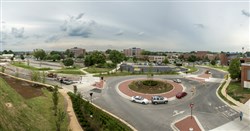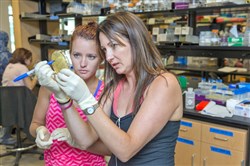VOL. 38 | NO. 34 | Friday, August 22, 2014
MTSU’s goal: Students graduating on time
By Sam Stockard

In this June file photo, motorists navigate the partially completed Champion Way/Lightning Way rotary on MTSU’s campus as road construction and landscaping continues. The project is expected to be finished later this fall and will improve traffic flow on the north side of campus.
-- Submitted Photo Courtesy Of Mtsu And Andy HeidtTennessee’s higher education funding formula is based largely on retaining students, and Middle Tennessee State University plans to stay focused on student support in 2014.
The university initiated the “Quest for Student Success” in October 2013 in an effort to keep students on track and boost its 52 percent graduation rate to 62 percent by 2020.
MTSU is adding a vice provost position to oversee student retention and success, and Richard Sluder is slated to join the staff in mid-September after leading efforts at the University of Central Missouri to improve graduation rates.
The vice provost post “will be particularly focused on creating a learning environment where high expectations for student learning are linked to a(n) … effective system of academic support initiatives,” MTSU President Sidney McPhee says.

Graduate lab classes have already started using the facilities inside the new MTSU Science Building. Lab supervisor and third-year doctoral student Ashley Cole, right, assists graduate student Dianna Prince in the study of molecular genetics in a biotech lab.
-- Submitted Photo Courtesy Of Mtsu And J. IntintoliSome 40 student advisors are to be hired and new computer software installed so they can assist students with class schedules, monitor their progress throughout the semester and help them avoid stumbling blocks along the way.
One professional advisor will be available for 300 students, according to Debra Sells, MTSU’s vice president for Student Affairs.
Student tutoring will be consolidated at Walker Library to ensure it’s easily accessible to students, and a page on the university’s website can steer them toward help they need, as well.
MTSU is focused on “everything we can do to help students be successful and graduate in four years,” Sells explains.
In addition, courses in which students struggle the most are being vetted to determine what makes them harder, according to Sells. They’ll be redesigned to incorporate new teaching techniques, additional support and other methods that can ensure students master them.
Besides the extra effort on student support and advice, MTSU will increase recruitment of students who show the potential to success at a four-year comprehensive university and use more innovative techniques to help them flourish.
Studying why enrollment is flat
Projected enrollment for MTSU freshmen is expected to be relatively flat. The university’s fall 2013 enrollment was 23,878, down considerably from recent years when it topped 26,000, largely because of the region’s improving economy putting people back in the workforce.
In bad economies, enrollment typically increases, Sells says.
MTSU has analyzed the reasons for its enrollment dip over the last two to three years, and Sells said it can be attributed to a national and state drop in the number of high school graduates.
The university also will monitor the impact of Gov. Bill Haslam’s Tennessee Promise under which students can attend the state’s community colleges tuition-free.
At universities such as MTSU, freshmen and sophomores will lose $500 each year on their Hope Scholarship money, but they’ll pick up $500 more as juniors and seniors.
The year begins Aug. 23 with the President’s Celebration in Floyd Stadium where students will take the True Blue pledge and become part of MTSU. Classes start Aug. 25.
MTSU students are staring at a 4.4 percent increase in maintenance/tuition and student fees at a total cost of $348. That includes $330 in maintenance/tuition and $18 in student fees.
Orange barrels everywhere
New and returning students will see completion of a $147 million Science Building, which already has offices and labs in use and will offer some classes this fall before an official opening is held.
Students are accustomed to navigating orange barrels amid street projects across campus, but traffic flow is expected to improve, university officials say.
Work continues on Lightning Way and Champion Way on the northeast side of campus where a new turning lane is installed at Greenland Drive along with a new rotary at their intersection and better pedestrian walkways, crosswalks and lighting.
Lightning Way at Founders Lane is expected to be paved and reopened in time for classes as excavation for water and steam pipes is completed.
The work is part of an $8.36 million project that includes construction of a parking lot – to be ready for the fall semester – just east of the Student Services and Administrations Center parking garage.
Also being done this year are a $3 million renovation of Cope Administration Building and a $2 million renovation on the McFarland Building, both of which had openings when the Student Services and Admissions Center opened.
Murphy Center is undergoing a $12.64 million renovation – set to be finished in two months – to restrooms, lighting and acoustics, along with new roofing and HVAC equipment.
Work also is to be finished this fall on a professional development center in the Ned R. McWherter Learning Resource Center, where the College of Education will be able to house 150 K-12 teachers to learn new teaching methods and standards.